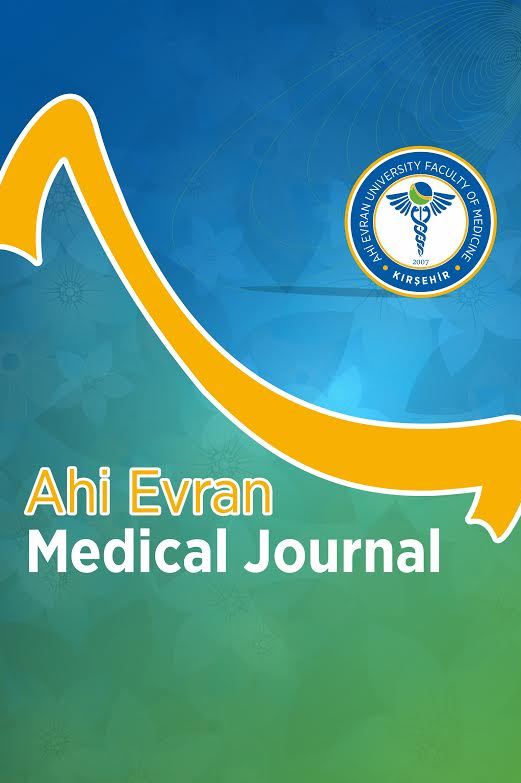PSÖDOFAKİK KİSTOİD MAKÜLA ÖDEMİ : ÜÇ OLGU SUNUMU
ÖZET Psödofakik kistoid maküla ödemi göz hastalıkları pratiğinde yoğun uygulanan katarakt cerrahisinin karşılaşılabilen bir komplikasyonudur. Bu çalışmada, kliniğimizde komplikasyonsuz katarakt cerrahisi geçiren ve sonrasında semptomatik psödofakik kistoid maküla ödemi gelişen üç olgu sunulmuş ve risk faktörleri ve tedavi etkinliği değerlendirilmiştir. Üç vakadan ilk olgu non-steroid antiinflamatuar ilacını kontrolsüz olarak kesmiş olması, ikinci olguda makülada epiretinal membran ve prostoglandin analoğu kullanımı olması, üçüncü olguda ise yaşa bağlı maküla dejenerasyonu bulgularının olması risk faktörleri olarak saptanmıştır. Santral maküla kalınlığının iki vakada 800 µ aşmasına rağmen medikal tedavi başlanılmış ve bu tedavi ile kistoid maküla ödeminin gerilemiş ve invazif tedavilere gerek kalmamıştır. Sonuç olarak psödofakik kistoid maküla ödemi gelişen hastalarda da öncelikle topikal ve oral olarak başlanan medikal tedavinin etkili olabileceği düşünmekteyiz.
Anahtar Kelimeler:
Psödofakik kistoid maküla ödemi, katarakt, fakoemülsifikasyon
PSEUDOPHAKIC CYSTOID MACULAR EDEMA: REPORT OF THREE CASES
SUMMARY Pseudophakic cystoid macular edema is a complication which can precede cataracts surgeries that performed intensely in ophthalmology practice. In this case report, three cases that underwent uncomplicated cataract surgery and with symptomatic psuedophakic cystoid macular edema occurrence were presented and risk factors and treatment efficiencies were evaluated. Among these three cases, the cessation of non-steroidal anti-inflammatory drop in the first case, epiretinal membrane on the macula and prostaglandin analogue use in the second case and age related macular degeneration in the third case were determined as the risk factors. Although the central macular thickness exceeded 800 µ in two of the cases medical treatment was initiated. Cystoid macular edema was resolved with this treatment and there was no need for invasive treatments. As a conclusion, we think that topical and oral medical treatment as the first line therapy for the patients with pseudophakic cystoid macular edema can be efficient.
___
- 1. Grzybowski A, Sikorski BL, Ascaso FJ, Huerva V. Pseudophakic cystoid macular edema: update 2016. Clinical interventions in aging. 2016; 11:1221-9.
- 2. Guo S, Patel S, Baumrind B, Johnson K, Levinsohn D, Marcus E, et al. Management of pseudophakic cystoid macular edema. Survey of ophthalmology. 2015; 60:123-37.
- 3. Kessel L, Tendal B, Jorgensen KJ, Erngaard D, Flesner P, Andresen JL, et al. Post-cataract prevention of inflammation and macular edema by steroid and nonsteroidal anti-inflammatory eye drops: a systematic review. Ophthalmology. 2014; 121:1915-24.
- 4. McCafferty S, Harris A, Kew C, Kassm T, Lane L, Levine J, et al. Pseudophakic cystoid macular edema prevention and risk factors; prospective study with adjunctive once daily topical nepafenac 0.3% versus placebo. BMC ophthalmology. 2017; 17:16.
- 5. Mitropoulos PG, Chatziralli IP, Peponis VG, Drakos E, Parikakis EA. Intravitreal Ranibizumab for the Treatment of Irvine-Gass Syndrome. Ocular immunology and inflammation. 2015; 23:225-31.
- 6. Garcia JM, Isaac DL, Avila MP. Dexamethasone 0.7 mg implants in the management of pseudophakic cystoid macular edema. Arquivos brasileiros de oftalmologia. 2016; 79:113-5.
- 7. Lin CJ, Tsai YY. Use of Aflibercept for the Management of Refractory Pseudophakic Macular Edema in Irvine-Gass Syndrome and Literature Review. Retinal cases & brief reports. 2016.
- Yayın Aralığı: Yılda 3 Sayı
- Başlangıç: 2017
- Yayıncı: Kırşehir Ahi Evran Üniversitesi
Sayıdaki Diğer Makaleler
KIRŞEHİR BÖLGESİNDE ÇOCUK HASTALARDA Helicobacter pylori SIKLIĞI
Fikriye Milletli Sezgin, Rukiye NAR, Ülken Tunga BABAOĞLU, Bilal İLANBEY
DİYABETİK RETİNOPATİ PATOGENEZİ VE TEDAVİSİ
FURKAN KURT, HURİYE ARIKAN, SÜMEYYE KARADOĞAN, HELİN KARAKUŞ, ESRA NUR KAĞITLI, RAŞİT KILIÇ
BİYOKİMYA LABORATUVARINDA PRE-PREANALİTİK HATA KAVRAMI
Rukiye NAR, Dilek İREN EMEKLİ, Kenan GÜÇLÜ, Bilal İLANBEY
OKSİDATİF STRESİN KANSERDEKİ ROLÜ: ANTİOKSİDANLAR KANSER PROGRESYONUNUN YAKITI OLABİLİR Mİ?
